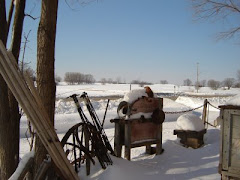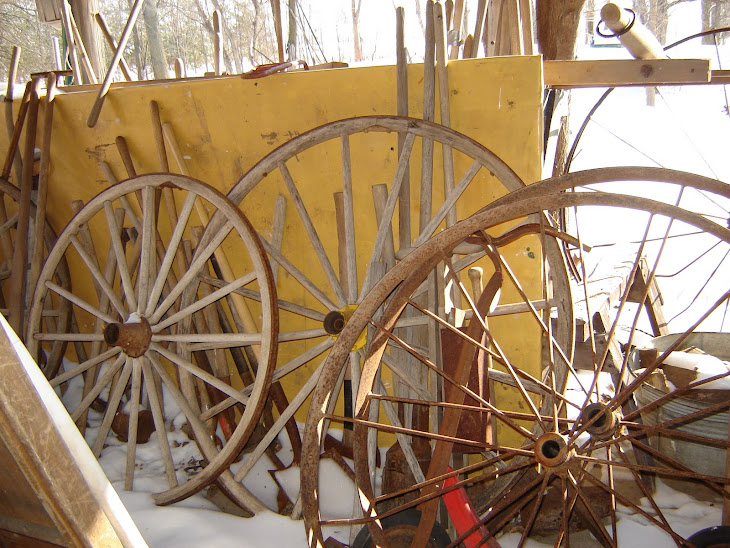(Tidbit on travel time for oxen) Oxen could travel one or two miles an hour pulling a stagecoach and didn’t require as much rest or as good a forage as horses or mules. They might do 10-12 miles in a 10 hour day. (terryburns.net)
Memories Antique Mall, Appleton and Antique Up, Kimberly 715-367-1199 (c), 920-788-3645 (h)
Featured Post
Whipping Up Something Good for Thanksgiving?
The Olde Plow Shoppe has you covered for whipping up something tasty for Thanksgiving. Do you have some of these tools or remember your pare...

Saturday, September 13, 2014
Two Oxen & Riders
(Tidbit on travel time for oxen) Oxen could travel one or two miles an hour pulling a stagecoach and didn’t require as much rest or as good a forage as horses or mules. They might do 10-12 miles in a 10 hour day. (terryburns.net)
Tuesday, September 2, 2014
Oak Table with 8 Chairs
This Oak Table with 8 Chairs is perfect for entertaining a large family or party!
Below is a history of Oak Furniture from onekingslane.com
Properties of Oak Timber
Oak is classified as a hardwood (vs. softwoods, like pine and other conifers)
texture is medium to coarse
oak dries very slowly, making it apt to split or check over time
color ranges from yellow brown to dark brown or grey with age.
a high tannin content means it’s especially resistant to fungus or insect damage, making it a great choice for principal structural timber and other fine carpentry
grows in woods and on hillsides throughout Europe, with the Common Oak and Sessile Oaks native to Great Britain
planks were first hewn from younger, green logs (easier to work with than dry timber) with an axe, then cut with a pit saw, which required two people to operate.
texture is medium to coarse
oak dries very slowly, making it apt to split or check over time
color ranges from yellow brown to dark brown or grey with age.
a high tannin content means it’s especially resistant to fungus or insect damage, making it a great choice for principal structural timber and other fine carpentry
grows in woods and on hillsides throughout Europe, with the Common Oak and Sessile Oaks native to Great Britain
planks were first hewn from younger, green logs (easier to work with than dry timber) with an axe, then cut with a pit saw, which required two people to operate.
Glossary of Oak Period Styles
Medieval [15th century], Tudor Gothic, Renaissance [1500s], Elizabethan [1558-1603], Jacobean [1603-1625]
New Furniture Pieces of the Oak Period
At the start of this period, benches and stools were the most common form of seating. English box stools, joined stools, and turned stools were far more common than chairs, but chairs were about to become the most
Quarter-sewn oak panels were used for interior wall paneling as well—as early as the 13th century. During the period of Henry III, these panels were painted to look like French tapestries.
Chests were central to almost every home. [Read more about The Evolution of the Chest.] Early hollowed-out chests, boarded chests (early 1500s) and finally framed-up chests (1550 on), the better construction of which inspired chairs, tables, cupboards, and other carpentry.
Chairs: boarded and panelled (most everything evolved from the panelled cheset), evolved from chest, then with arms and legs, panelled with Wainscot-style carving on back & slight rake to back, turned; benches; Cromwellian and Derbyshire chairs; the Farthingale chair, upholstered armchair, upholstered x-frame chair;
Tables first started evolving in the Oak Period—direct descendants of the chest. First, simpletrestle tables popped up, being easy to break down and move. Then, more solid dining tables arose: Elizabethan “draw tables” with extending leaves, with stretchers and bulbous legs. Jacobean dining tables with six or more baluster-turned legs and stretchers. Tables for things other than dining evolved out of a more leisurely lifestyle, like gate-leg and double-gate-leg tables.
Side tables, and early versions of console tables
Quarter-sewn oak panels were used for interior wall paneling as well—as early as the 13th century. During the period of Henry III, these panels were painted to look like French tapestries.
Chests were central to almost every home. [Read more about The Evolution of the Chest.] Early hollowed-out chests, boarded chests (early 1500s) and finally framed-up chests (1550 on), the better construction of which inspired chairs, tables, cupboards, and other carpentry.
Chairs: boarded and panelled (most everything evolved from the panelled cheset), evolved from chest, then with arms and legs, panelled with Wainscot-style carving on back & slight rake to back, turned; benches; Cromwellian and Derbyshire chairs; the Farthingale chair, upholstered armchair, upholstered x-frame chair;
Tables first started evolving in the Oak Period—direct descendants of the chest. First, simpletrestle tables popped up, being easy to break down and move. Then, more solid dining tables arose: Elizabethan “draw tables” with extending leaves, with stretchers and bulbous legs. Jacobean dining tables with six or more baluster-turned legs and stretchers. Tables for things other than dining evolved out of a more leisurely lifestyle, like gate-leg and double-gate-leg tables.
Side tables, and early versions of console tables
the hutch, both an early planked version with doors, and a later framed-up hutch with Gothic carving. Evolving from the chest, these were examples of the earliest forms of cupboards—places to store food and an array of dishes that people were beginning to accumulate. Later in the 17th century, these were called Farmhouse dressers, many with open shelving resembling the modern china cabinet.
Elizabethan court cupboards were enormous, architectural pieces with “standing cup and cover” columns—spectacular examples of every form of ornamentation used during the period. They comprised a buffet (two-tiered shelved unit) with lower cabinet storage. court cupboard and buffet (3 tiers open on all sides) court cupboards relaxed in ornament, then phased out around 1650.
Bedroom furniture: Elizabethan & Jacobean bedsteads: four-poster, panelled, and canopied, draped in upholstery; wardrobes
Bible boxes with sloping lids to rest the book while being read, and locked compartments. The bible was a family’s most prized possession!
Commodes, or chests of drawers
Common Decorative Motifs
Elizabethan court cupboards were enormous, architectural pieces with “standing cup and cover” columns—spectacular examples of every form of ornamentation used during the period. They comprised a buffet (two-tiered shelved unit) with lower cabinet storage. court cupboard and buffet (3 tiers open on all sides) court cupboards relaxed in ornament, then phased out around 1650.
Bedroom furniture: Elizabethan & Jacobean bedsteads: four-poster, panelled, and canopied, draped in upholstery; wardrobes
Bible boxes with sloping lids to rest the book while being read, and locked compartments. The bible was a family’s most prized possession!
Commodes, or chests of drawers
Common Decorative Motifs
The biggest shift of the Oak Period was the change to domestic life. Homes were no longer treated like fortresses, or communal great halls. Elizabethan homes were smaller, and with the increase in a cultural society, gracious architectural lines broke free from the old feudal style fortresses. New rooms required new furniture, and luxury ensued.
- Legs & Feet: Trestle shapes, turned, with leaf carving, and sturdy block legs; Jacobean: turned, twist turned, urn-shaped
- Gothic carving filled the home just like stonemason work in buildings: flutes, facets, arches, rose window piercing, curved rib designs; by Tudor period, linenfold paneling
- Renaissance, Italian ornament, with arabesques, Romagne panels, with carved heads, faces, wreaths, ribbon, floral and scrolls; and painted furniture, cassoni panels.
- “wainscot” paneling on walls. named for Dutch word “wagenschot” designating the finest quality of quartered oak. walls were colored and gilded.
- Standing cup and cover columns (by 1600, this was replaced with pear shaped turning), legs with bulbous turning, deep carved friezes;
- Early Stuart (1603-1625) panels with arches showing a perspective or landscape, like a garden with figures and pictures from books imported from the Low Countries
- Jacobean applied paneling, ornaments, and moulding: Renaissance style, like lozenge, guilloche, lunette, and arcaded panels. In Elizabethan, ornament was with purpose, like to soften edges; in Jacobean, it was just wherever it could go.
- By late Stuart, inlaid decoration was more common. It started out pretty clumsy, with geometry patterns, but got better and prettier with flowers in vases and stuff. Cornice moldings, Cromwellian period: oak treated with beeswax or turpentine; chairs with stamped and tooled leather, string of bead turning; twist turning improved. Spindles and balusters cut in half then glued on flat surface.
Monday, September 1, 2014
Stage Coach Photo Op
Dennis aboard his stagecoach!
Dennis' sister Julie and her great-dane Roxy. Looks as though Roxy could pull the stagecoach!
Dennis' sister Julie and her great-dane Roxy. Looks as though Roxy could pull the stagecoach!
So who else wants to come? The Olde Plow Shoppe is open today Labor Day.
Let us know if you want to be posted on our blog.
email your photos to: gbmwclark@hotmail.com
Subscribe to:
Comments (Atom)
Front Yard Shop

Front Display
Buggy Wheels

Under Lean-to




